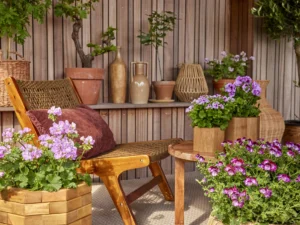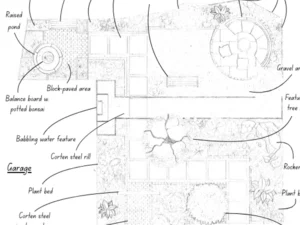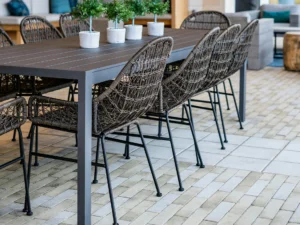Introduction
Fencing plays a crucial role in defining boundaries, adding privacy, and enhancing the aesthetic appeal of your garden. However, with so many different fencing types available, selecting the best option for your needs can feel overwhelming.
In this guide, we will explore five popular fencing types, outline the factors you should consider when making your decision, and provide an overview of the rules and regulations homeowners need to be aware of. We’ll also offer alternative solutions if standard fencing isn’t suitable for your property and show how NGS can help you navigate these choices with ease.
Different Types of Fencing
- Wooden Panel Fencing
- Vinyl (PVC) Fencing
- Metal Fencing
- Wire Mesh Fencing
- Composite Fencing
Wooden Panel Fencing
Wooden panel fencing is one of the most popular and traditional choices for residential properties. It’s typically constructed using horizontal or vertical timber panels that offer privacy and a natural appearance. However, you can also use wooden slatted fencing as a great alternative as it provide you with privacy from prying neighbours.
A benefit of wooden fencing is its versatility; it can be stained or painted to complement any garden style. However, wood requires regular maintenance, such as painting or staining, to prevent rot and weather damage.
At NGS, we have a carpenter within our team, who can help you achieve your dream fence aesthetic. To find out more, head to our Contact Us page and make an enquiry.
Vinyl Fencing
Vinyl fencing is a low-maintenance alternative to wood. Made from durable plastic, it can withstand various weather conditions without the need for painting or treating. Vinyl fences are easy to clean and resistant to rotting, making them an attractive option for busy homeowners.
On the downside, vinyl can be more expensive upfront than traditional wood, and some people find the look of plastic less appealing than natural materials.
Metal Fencing
Metal fencing, such as wrought iron or aluminium, is known for its durability and elegant design. Metal fences often serve as decorative features that provide security without completely blocking the view.
One of the key advantages of metal fencing is its strength and ability to resist impact or attempts to breach it. However, metal fencing is prone to rust and corrosion if not properly treated, and it may require occasional repainting or rust-proofing.
Wire Mesh Fencing
Wire mesh fencing is a practical option, often used in large gardens, farms, or areas where securing the boundary is more important than privacy. This fencing type is typically lightweight and relatively easy to install.
While it provides security, it does not offer much in the way of privacy and may not be as aesthetically pleasing as other fencing options.
Composite Fencing
Composite fencing is made from a combination of wood fibres and plastic, creating a material that offers the look of wood but with less maintenance. This fencing type is eco-friendly and highly durable, resistant to rot, insects, and fading.
However, composite fencing can be one of the more expensive options on the market and may not have the same warmth as natural wood.
Considerations When Choosing the Right Fence
When deciding which fence to install, there are several factors to keep in mind. First, consider the purpose of your fence. Are you looking for privacy, security, or simply a decorative boundary?
Different fencing materials and designs serve different purposes, so it’s important to choose based on your needs. Additionally, think about the long-term maintenance required for each type of fence.
While some materials like vinyl or composite are low-maintenance, wood will need more frequent attention. Finally, consider the aesthetics of the fence and how it complements your home and garden.
Choosing the right type of fencing is crucial not only for practical reasons but also for creating the desired atmosphere in your outdoor space. Your fence should serve its purpose while also blending in with your garden’s overall design. Making the right choice can add value and appeal to your property for years to come.
Fencing Rules and Regulations
Before installing a fence, it’s important to understand the laws and regulations that govern fencing in residential areas. These rules can impact your options and should be a starting point in the decision-making process. Here are three key rules to be aware of:
Height Restrictions
In the UK, residential fences are typically limited to a height of 2 metres without planning permission. If you want to build a fence that exceeds this height, especially near the front of your property, you will need to apply for planning permission from your local council.
Boundary Agreements
Before erecting a fence, it’s crucial to check boundary agreements with your neighbours. These agreements dictate which side of the boundary is your responsibility and can affect where the fence should be placed and who is responsible for its maintenance.
Protected Areas
Some areas, such as conservation zones or properties near listed buildings, may have additional restrictions on the type of fencing you can install. In these cases, you may need special permission or adhere to specific design guidelines.
If you’re concerned that your desired fence may not abide by the rules and regulations surrounding residential or commercial fencing, then do not hesitate to get in touch via our Contact Us page!
Fencing Alternatives
If the standard fencing options don’t meet your needs due to legal restrictions, there are alternative solutions. For instance, if height restrictions are an issue, one way to increase privacy is by planting trees or shrubs within your boundary.
Pleached trees, which are trained to grow in a flat, screen-like formation, are an excellent option for adding height and privacy without violating height limits. Additionally, they provide a more natural and aesthetically pleasing alternative to tall fences.
For boundary agreements, rather than installing a physical fence, consider using natural barriers like hedges. These can mark the boundary clearly while requiring less negotiation with neighbours. In protected areas where specific fence types may be prohibited, opt for materials that blend more naturally into the landscape, such as living walls or trellises with climbing plants.
How NGS Can Install the Perfect Fence
Choosing the right fence can be a daunting task, but NGS is here to help guide you through the process. Our team of experts can assist in selecting the best fencing option for your needs, taking into account your garden’s layout, design goals, and any legal restrictions.
With years of experience in professional fence installation, NGS ensures that your fence will not only look great but will also stand the test of time.
Whether you need a traditional wooden fence or a modern composite solution, our skilled team provides quality craftsmanship and advice to create the perfect fencing for your property. We also offer guidance on maintaining your fence, so it stays in top condition throughout the seasons.
To find out more about how NGS can help you choose and install the perfect fence, head to our Contact Us page to get in touch!
Further Reading
Secure your Space: Exploring the Best Wooden Fencing Near Me
Essential Fence Care Summer Tips
Kiln-Dry Oak vs. Wet Oak: Choosing the Right Wood for your Projects
Make a Statement with Bespoke Wooden Garden Structures














